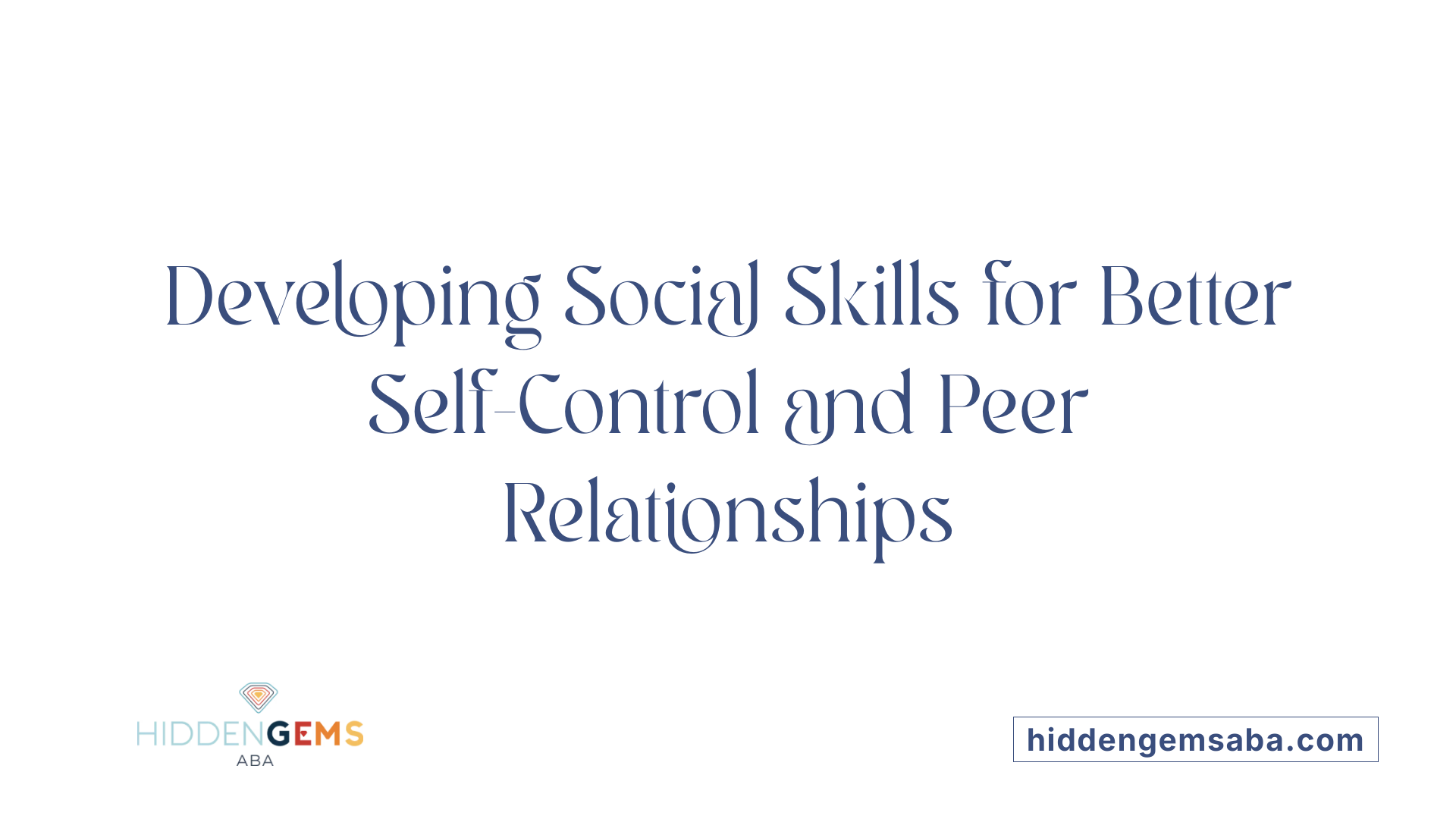Understanding ABA Therapy and Its Role in Developing Self-Control
Applied Behavior Analysis (ABA) therapy has established itself as a leading approach to support children with autism in developing crucial skills, including self-control. This article examines how ABA therapy fosters self-regulation by using evidence-based strategies and personalized interventions designed to improve behavior, communication, and independence.
What is Applied Behavior Analysis (ABA) Therapy?
What is applied behavior analysis (ABA) therapy in the context of autism?
Applied Behavior Analysis (ABA) therapy is a scientifically validated treatment designed to improve social, communication, and learning skills in individuals with autism spectrum disorder (ASD). It is grounded in behavioral science principles that analyze how behaviors are learned and maintained through interactions with the environment.
Definition and core principles of ABA
ABA focuses on understanding and modifying behavior using systematic methods. The core techniques include positive reinforcement to encourage desired behaviors, prompting to guide correct responses, shaping to gradually build complex skills, and modeling appropriate actions. Therapists assess individual behaviors to identify antecedents (triggers) and consequences, enabling targeted interventions to increase beneficial behaviors and reduce challenging ones.
Behavioral science foundation
ABA is rooted in behavioral science, applying experimental and observational analyses to create data-driven treatment plans. By regularly collecting and reviewing data, therapists can tailor interventions to the unique needs of each child. This scientific approach ensures continuous progress and helps optimize behavioral outcomes.
Importance in autism treatment
ABA therapy is considered a cornerstone treatment for children with autism. It addresses core impairments such as communication difficulties, social interaction challenges, and adaptive skills deficits. Early and intensive ABA interventions have been demonstrated to significantly enhance cognitive functioning, promote greater independence, and improve daily living skills. By fostering essential abilities in structured, supportive environments, ABA enables individuals with autism to better integrate socially and function more autonomously across settings.
Who Provides ABA Therapy? Professionals Behind the Approach
Who typically provides therapy focusing on autism and behavioral analysis?
ABA therapy is delivered by a team of trained professionals specialized in behavioral science and autism intervention. The primary providers include Board Certified Behavior Analysts (BCBAs), who oversee assessment, develop individualized intervention plans, and supervise implementation. Registered Behavior Technicians (RBTs) and therapists often carry out daily therapy sessions, working directly with the child.
Settings where therapy is provided
ABA therapy takes place in diverse environments tailored to the child's needs. These include in-home visits, specialized center-based programs, schools, and community settings. Offering therapy in multiple settings helps children generalize skills across real-life situations.
Importance of family involvement
Caregiver and family participation is fundamental in ABA therapy. Families learn behavioral strategies and communication supports to reinforce progress consistently outside therapy hours. Parent training sessions equip caregivers to manage challenging behaviors, promote communication development, and support emotional regulation, ensuring a collaborative approach to the child's growth.
Together, this multidisciplinary structure and involvement from both professionals and families maximize ABA therapy's effectiveness, fostering lasting improvements in independence, social skills, and emotional control for children with autism.
Core Techniques Used in ABA to Develop Self-Control

Positive Reinforcement to Encourage Desired Behaviors
ABA therapy relies heavily on positive reinforcement as a central strategy to promote self-control in children with autism. This technique involves rewarding desirable behaviors immediately after they occur, thereby increasing the frequency of these behaviors. For example, when a child successfully manages frustration without an outburst, they might receive praise or a small reward. Over time, these positive experiences help shape better self-regulation and emotional control.
Prompting, Shaping, and Modeling Techniques
To teach complex behaviors like self-control, ABA therapists use prompting, shaping, and modeling. Prompting offers cues or assistance to guide the child toward the correct behavior, which is gradually faded as independence grows. Shaping breaks down the desired behavior into smaller steps, reinforcing progress toward the ultimate goal. Modeling shows the child how to behave by example, allowing them to imitate appropriate actions. These methods work synergistically to build and refine self-control skills step-by-step.
Use of Discrete Trial Training (DTT) and Natural Environment Training (NET)
ABA incorporates structured teaching methods such as Discrete Trial Training (DTT), which provides repetitive, focused learning trials to teach specific self-control skills. Each trial consists of a clear instruction, the child's response, and immediate reinforcement or correction.
Natural Environment Training (NET), on the other hand, uses everyday situations to teach and reinforce self-control. This approach encourages generalization of skills by prompting children to apply self-regulation during normal activities, such as sharing toys or taking turns during play. Together, DTT and NET ensure children not only learn self-control in clinical settings but also carry these skills into daily life.
These techniques combine to create an individualized and systematic approach that helps children develop self-management and emotional regulation abilities essential for their growth and social integration.
Individualized Treatment Plans: Tailoring ABA to Each Child

How are skills and challenging behaviors assessed in ABA therapy?
ABA therapy begins with a thorough assessment of each child's skills and the challenging behaviors they exhibit. Therapists, often Board Certified Behavior Analysts (BCBAs), use direct observation and data collection to identify triggers and patterns. This behavioral analysis helps determine what skills the child has mastered and which require support, forming the basis for an individualized treatment plan.
How is ABA customized to a child's strengths and needs?
Each child’s plan is uniquely tailored to their abilities and challenges. The therapist considers the child’s strengths, preferences, and areas needing development to create targeted goals. This ensures interventions are relevant and motivating. For example, a child with strong visual skills may receive more visual supports, while another may benefit from communication-focused techniques.
What foundation skills are emphasized in these plans?
Individualized plans prioritize foundational skills essential for daily life and learning. Communication skills, including expressing needs and social interaction, are central. Self-control skills, such as managing emotions and behaviors, are also emphasized through strategies like self-management and positive reinforcement. By focusing on these building blocks, ABA therapy helps children gain independence and improve social functioning.
These tailored plans are dynamic, with continuous data monitoring allowing therapists to adjust strategies for optimal progress and long-term success.
Behavioral Analysis and Data-Driven Progress Monitoring
What is the role of behavior analysis in identifying triggers and targets?
Behavior analysis plays a central role in ABA therapy by carefully examining behaviors to identify what triggers them and determining which actions need to be modified or encouraged. This process helps therapists understand challenging behaviors, assess their causes, and develop tailored intervention plans focused on promoting positive behaviors while reducing undesired ones.
Why is regular data collection and analysis important?
Consistent data collection is essential in ABA to track a child's progress throughout therapy. Therapists gather detailed information on behaviors, skills acquired, and response to interventions. This data helps monitor improvements or challenges objectively, ensuring that decisions are based on evidence rather than assumptions.
How are interventions adjusted to maximize effectiveness?
By analyzing collected data, professionals can identify which strategies work best for each child. Interventions are continuously refined, whether by modifying reinforcement techniques, altering environments, or introducing new teaching methods. This dynamic approach ensures that therapy remains personalized and effective, adapting to the child's evolving needs.
Together, behavior analysis and data-driven monitoring create a responsive framework in ABA therapy that supports meaningful, measurable progress for children with autism and other developmental disabilities.
Self-Management: Teaching Children to Control Their Own Behavior

What is Self-Management in ABA Therapy?
Self-management in Applied Behavior Analysis (ABA) refers to a set of strategies that enable children, particularly those with autism spectrum disorder (ASD), to control and regulate their own behaviors. By learning to manage their own actions, children develop greater independence and reduce reliance on external prompts or adult assistance, which is a common challenge in behavioral interventions.
Core Components of Self-Management
Self-management interventions typically include several interrelated components:
- Goal Setting: Children establish clear, specific behaviors or skills they aim to develop or improve.
- Self-Monitoring: Individuals track their own behaviors in real time, increasing self-awareness.
- Self-Evaluation: Children assess their performance against their goals, fostering reflection and responsibility.
- Self-Reinforcement: They learn to reward themselves for achieving targets, supporting motivation.
- Self-Instruction: Children use verbal or cognitive cues to guide their behavior in various situations.
These components often work together in a package, helping children practice and internalize behavioral regulation and decision-making skills.
How Self-Management Reduces Dependence on External Prompts
By teaching children to cue and control their own behaviors, self-management strategies effectively address prompt dependency—a situation where individuals wait for external signals before responding appropriately. Through self-management, children learn to recognize when and how to initiate behaviors independently, which promotes skill generalization across settings such as home, school, and community.
Broader Benefits
Self-management has demonstrated effectiveness across numerous areas, including enhancing social interactions, academic performance, and daily living skills. This approach is recognized through extensive research as an evidence-based practice improving social responsiveness, conversational abilities, and emotional regulation for individuals with ASD.
Employing self-management within ABA therapy thus empowers children not only to manage behaviors but also to gain autonomy, supporting long-term success and quality of life improvements.
Benefits of Self-Management in Developing Independence
Enhancing Social Responsiveness and Daily Living Skills
Self-management interventions within ABA therapy have demonstrated significant benefits in improving social responsiveness and daily living abilities for individuals with autism spectrum disorder (ASD). These interventions help develop crucial skills such as initiating conversations, recognizing non-verbal cues, engaging in appropriate play, compliment giving, and performing academic tasks like writing and following directions. Moreover, self-management strategies support the acquisition of daily living and health-related behaviors, including physical activity, which enhances overall independence.
Mitigating Prompt Dependency
A common challenge in behavioral teaching is prompt dependency, where individuals rely heavily on external cues to perform tasks. Self-management techniques combat this by teaching individuals to cue themselves in appropriate situations, fostering greater autonomy. By incorporating practices such as self-monitoring, self-evaluation, and self-reinforcement, individuals gradually decrease reliance on prompts and support, leading to enhanced self-control and function.
Supporting Maintenance and Generalization of Skills
Self-management not only aids in acquiring new skills but also promotes their maintenance and generalization across varied settings. Through goal setting and self-instruction, individuals learn to apply learned behaviors consistently in different environments beyond therapy sessions. Although further research is needed to strengthen evidence on long-term maintenance, current findings suggest that self-management supports sustained behavioral improvements and social integration for individuals with ASD.
Addressing Emotional Regulation through ABA Strategies
How does ABA therapy teach coping strategies for frustration and anxiety?
ABA therapy uses individualized interventions to help children recognize signs of emotional distress and employ coping skills effectively. Techniques such as positive reinforcement encourage attempts to use calming strategies like deep breathing or requesting help. Therapists also model and prompt adaptive responses, gradually shaping the child's ability to manage difficult feelings independently.
How are triggers for emotional outbursts identified in ABA therapy?
A critical part of ABA is conducting a functional behavior assessment, where therapists observe and collect data to uncover environmental, social, or sensory triggers that lead to emotional outbursts. Understanding these triggers allows the development of targeted interventions that reduce the child's exposure to those stimuli or teach alternative responses.
In what ways does ABA improve behavioral regulation and self-control?
ABA prioritizes self-management techniques that empower children to monitor and regulate their emotions and actions. Through goal setting, self-monitoring, and self-reinforcement strategies incorporated into therapy, children learn to delay reactions, choose appropriate behaviors, and generalize these skills across settings. This leads to improved emotional regulation, less frequent outbursts, and better social interactions.
Overall, ABA's structured and data-driven methods provide children with autism clear pathways to recognize their emotions, cope effectively with challenges like frustration and anxiety, and build lasting self-control skills that enhance daily functioning and social integration.
Role of Caregivers and Family in Supporting Self-Control Development
How does caregiver training enhance the effectiveness of ABA therapy?
Caregiver training in ABA techniques equips families with the knowledge and skills to support their child's development of self-control and other important behaviors accurately. By understanding how to implement strategies like positive reinforcement and prompting, caregivers can help manage challenging behaviors and encourage adaptive skills consistently.
Why is reinforcement of skills outside therapy sessions important?
Reinforcing skills learned during therapy in everyday environments helps children generalize and maintain their progress. When caregivers apply ABA principles at home or in community settings, it fosters repeated practice and strengthens the child's ability to use self-control independently across different contexts.
What is the significance of fostering consistent environments across settings?
Consistency between therapy sessions and home life creates predictable routines that reduce anxiety and confusion for children. A stable and structured environment supports the retention of new skills and smooths transitions, which are crucial for emotional regulation and self-management. Families who collaborate closely with therapists ensure that interventions are aligned, maximizing benefits for the child’s growth and independence.
Social Skills and Peer Interaction: Key Areas Influencing Self-Control

Encouraging appropriate social behavior
ABA therapy plays a vital role in promoting appropriate social behaviors in children with autism by providing structured interventions. These interventions reinforce positive social interactions, helping children understand how their actions affect others and encouraging behaviors that lead to successful peer relationships.
Teaching turn-taking, eye contact, initiating conversations
Specific social skills such as turn-taking, maintaining eye contact, and initiating conversations are systematically taught through ABA techniques like prompting, modeling, and positive reinforcement. These skills are broken down into manageable steps and practiced repeatedly, enabling children to engage more confidently and effectively in social settings.
Using social stories to illustrate norms and responses
Social stories are an important ABA tool used to educate children about social norms and appropriate responses in various situations. By presenting scenarios in a clear and relatable way, social stories help children anticipate and navigate social interactions, reducing anxiety and supporting better self-control and social responsiveness.
Combining ABA with Other Therapies for Holistic Support
How does ABA therapy integrate with speech, occupational, and sensory integration therapies?
ABA therapy often works best when combined with other therapeutic approaches to address the diverse needs of children with autism. Speech therapy complements ABA by focusing specifically on communication skills, helping children develop verbal and nonverbal language abilities alongside ABA's structured behavior techniques. Occupational therapy targets fine motor skills, sensory processing, and daily living skills, which can enhance a child's ability to participate more fully in ABA interventions. Sensory integration therapy, when used with ABA, aims to improve sensory processing and reduce sensitivities, making the child more comfortable and better able to engage in learning activities.
How does ABA address co-occurring conditions such as anxiety or ADHD?
Many children with autism also experience other conditions like anxiety, ADHD, or sensory processing disorders. ABA's individualized treatment plans are designed to identify and target specific challenges in behavior and emotional regulation. By teaching coping strategies, self-management skills, and providing structured routines, ABA helps children manage anxiety and improve focus in the presence of ADHD symptoms. Positive reinforcement and skill-building techniques also support emotional regulation and reduce behavioral difficulties associated with these co-occurring conditions.
How does combining therapies enhance overall developmental outcomes?
Integrating ABA with complementary therapies creates a comprehensive support system tailored to each child's unique needs. This holistic approach promotes progress across multiple domains such as communication, social interaction, sensory processing, and emotional well-being. Collaborative efforts between BCBAs, speech therapists, occupational therapists, and families maximize learning opportunities, ensuring consistent reinforcement across environments. The result is improved independence, better social skills, and enhanced daily living abilities, forming a strong foundation for lifelong growth and success.
Early Intensive Intervention: The Impact on Long-Term Outcomes

Significance of Starting ABA at a Young Age
Early intensive behavioral intervention through ABA therapy is critical for children with autism spectrum disorder (ASD). Initiating treatment at a young age allows therapists to leverage the brain's early plasticity, leading to more effective and lasting developmental gains. Research shows that starting ABA therapy early can substantially enhance communication, social interaction, and behavioral regulation.
Improving Communication, Social Skills, and Behavioral Regulation
ABA therapy targets foundational skills by breaking down complex behaviors into manageable steps. Through positive reinforcement and individualized plans, children learn to communicate more effectively, engage socially, and manage emotions. Self-management strategies reduce problem behaviors like aggression and frustration by teaching children to cue themselves and take control of their actions. Social skills, such as making eye contact and initiating conversations, are cultivated systematically, promoting smoother peer interactions and emotional well-being.
Potential for Greater Independence in Adulthood
Higher independence in adulthood is a major goal realized through early and consistent ABA intervention. By gradually building adaptive behaviors and daily living skills, children can handle transitions, perform tasks, and regulate emotions without constant support. Caregiver involvement and consistent application of ABA principles both at home and therapy sessions reinforce retention and generalization. Ultimately, early intervention lays a foundation for children with ASD to achieve greater self-reliance, improved quality of life, and successful integration into society.
Using Positive Reinforcement to Promote Self-Control and Independence

How reinforcement increases desired behaviors
Positive reinforcement is a foundational technique in ABA therapy that encourages the repetition of desired behaviors by rewarding them immediately. When children with autism receive positive feedback—such as praise, tokens, or preferred activities—after demonstrating appropriate behaviors, they are more likely to repeat those behaviors. This systematic rewarding builds motivation and reinforces learning, creating a structured environment that supports gradual skill acquisition and self-control.
Encouraging functional communication and adaptive skills
ABA therapy uses positive reinforcement to teach vital communication and adaptive skills. By breaking down complex tasks into manageable steps and reinforcing each successful attempt, children learn to initiate and maintain functional communication, better navigate daily routines, and develop independence in self-care. Techniques like prompting and modeling combined with reinforcement increase the likelihood that children will adopt skills such as requesting help, using words or gestures, and managing emotions effectively.
Reducing challenging behaviors through alternative actions
Instead of only focusing on suppressing challenging behaviors, ABA leverages positive reinforcement to teach and strengthen alternative, functional behaviors. By identifying triggers for behaviors such as aggression or self-injury, therapists design interventions that reward appropriate substitutes, like using words to express frustration or engaging in calming activities. This replacement approach helps children gain self-control, reduces problem behaviors, and encourages autonomy, contributing to improved social interaction and emotional regulation.
Managing Challenging Behaviors with ABA Approaches
Identifying behavioral triggers and antecedents
ABA therapy begins managing challenging behaviors by carefully analyzing the child's environment to identify triggers and antecedents that lead to unwanted behaviors. Professionals use behavioral analysis techniques to pinpoint what causes or precedes behaviors such as aggression or self-injury. This allows therapists to design targeted intervention plans that focus on modifying those triggers or teaching the child to respond differently.
Teaching replacement behaviors
Once triggers are identified, ABA focuses on teaching replacement or alternative behaviors that serve the same function but are more acceptable. Using systematic methods such as positive reinforcement, prompting, and modeling, children learn new skills like communication strategies or self-control techniques. Self-management strategies are also employed, teaching children to cue themselves and reduce prompt dependency, promoting independence in behavior regulation.
Improving social integration through behavior management
By reducing challenging behaviors and enhancing positive social skills, ABA supports better social integration. Therapists help children develop essential social behaviors like making eye contact, initiating conversations, and taking turns. Caregiver involvement and consistent reinforcement across home and therapy sessions further strengthen these skills. Structured routines and social stories help children understand social norms and expectations, facilitating smoother interactions in various settings.
These strategies collectively foster improved self-control, emotional regulation, and adaptive social functioning, essential for daily life and community participation.
Creating Structured Routines to Support Emotional and Behavioral Regulation
Providing predictability and reducing anxiety
ABA therapy uses structured routines to create a predictable environment, which helps reduce anxiety and behavioral challenges in children with autism. Predictability gives children clear expectations about what to expect, which lowers stress and promotes calmness.
Developing time-management and daily living habits
Through consistent routines, ABA encourages the development of essential time-management skills and daily living habits. Structured schedules guide children in completing tasks independently, fostering self-reliance and improving their ability to manage daily activities effectively.
Supporting smooth transitions and adaptability
Transitions can be difficult for children with ASD. ABA uses visual schedules and positive reinforcement within structured routines to support smooth transitions between activities. This approach increases adaptability, reducing anxiety during changes and helping children adjust more easily to new or unexpected situations.
Ethical Practices and Family Engagement in ABA Therapy
How is informed consent and the use of least restrictive interventions ensured in ABA therapy?
ABA therapy emphasizes ethical practices by prioritizing informed consent and employing the least restrictive interventions. Before treatment begins, practitioners thoroughly explain the therapy approach to families, ensuring their understanding and voluntary agreement. The therapy uses strategies that respect the individual's autonomy and dignity, avoiding overly intrusive methods and focusing on gentle, positive reinforcement techniques.
How does ABA therapy respect individual needs and neurodiversity?
ABA professionals tailor interventions to each child's unique strengths, preferences, and challenges, ensuring respect for neurodiversity. Treatment plans are individualized, aligning goals with the child's specific communication styles and behavioral patterns. This respectful approach promotes acceptance and fosters a supportive environment that honors the child's identity while encouraging skill development.
Why is family involvement crucial for ABA therapy success?
Involving families in ABA therapy is fundamental to achieving consistent progress across settings. Caregivers receive training to implement strategies at home, reinforcing newly acquired skills and managing behaviors effectively. This collaboration creates a cohesive support system that enhances skill generalization, reduces behavioral challenges, and fosters emotional regulation in everyday life.
Overall, ethical ABA practices combined with active family engagement form the foundation for sustainable behavioral improvements and holistic development in children with autism spectrum disorder.
ABA Therapy: Empowering Self-Control for Lifelong Success
ABA therapy offers a scientifically grounded and personalized approach that helps children with autism develop essential self-control and behavioral regulation skills. Through techniques such as self-management, positive reinforcement, and consistent caregiver involvement, ABA fosters independence and improves emotional and social functioning. Early and intensive interventions contribute to significant long-term benefits, supporting children on their journey to greater autonomy and fulfilling community participation. By addressing individual needs and emphasizing ethical, respectful practices, ABA therapy continues to be a cornerstone in helping children build confidence and manage behaviors effectively.
References
- Kids On The Move: ABA Therapy in Utah
- ABA Therapy vs Traditional Preschool
- Self-Management Interventions
- Understanding ABA ASD: Key Benefits for Autism Treatment
- Applied Behavior Analysis (ABA)
- Applied Behavior Analysis (ABA)
- The Controversy Around ABA
- Treatment and Intervention for Autism Spectrum Disorder
- Applied Behavior Analysis (ABA)
- 5 Benefits Of ABA Therapy For Autism






